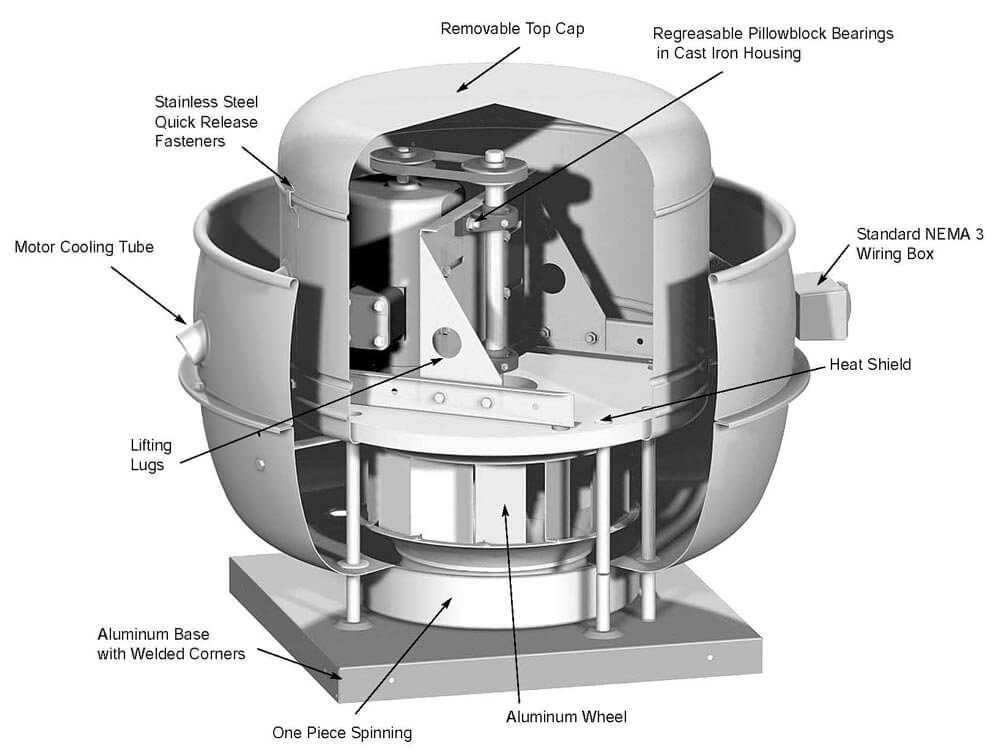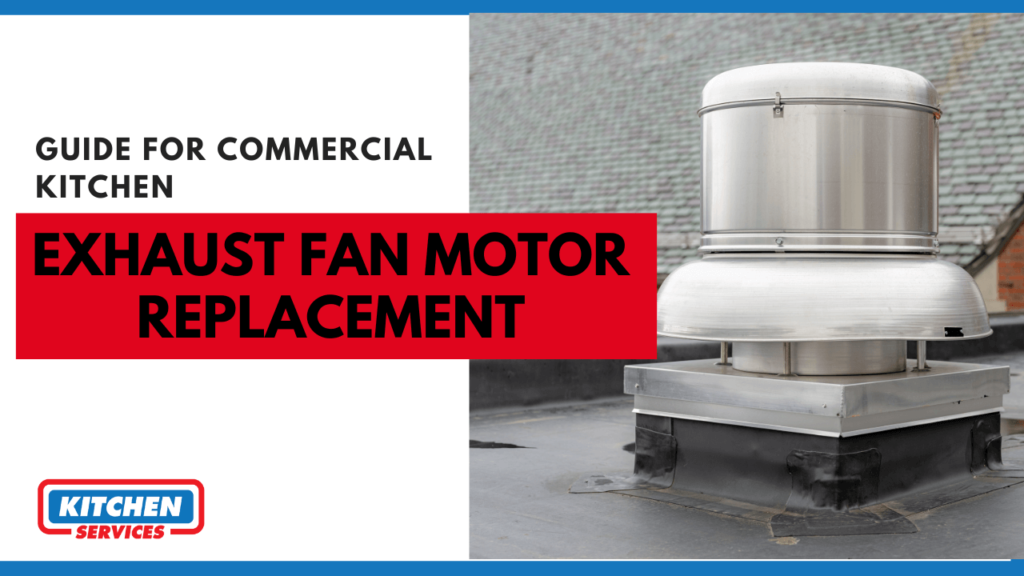We all know that completely functional exhaust and extractor fans are very critical in any commercial kitchen. Without having installed a completely functioning exhaust fan in your kitchen, you will have to close your business down. Exhaust fans are very important and critical to maintaining the air quality in the indoor environment by eliminating any particles and fumes of smoke, steam, as well as extracting oil and grease fibers from the kitchen. Any sort of grease that has built up inside the fans and motors of kitchen exhaust fans can ultimately damage them. You can easily remove your current fan and its motor and replace it with a new commercial kitchen exhaust fan motor in no time if you follow the proper instructions.
Why Is There a Need to Replace Your Exhaust Fan Motor?
If the motor of your commercial kitchen exhaust fan begins to make an unusual noise, it may be due to the fact that the motor is struggling to keep the fan running. When it gets to this stage, it is likely to be only a matter of time before the motor burns out completely. In this case, replacing the motor is the best option.
If you are looking for Commercial Kitchen Exhaust Fan Motor installer in Los Angeles and surrounding areas, we at Kitche Services provide highly skilled HVAC technicians who have specialized in commercial exhaust fan installation as well as restaurant exhaust hood installation services.
Basic Types of Exhaust Fan Motors

Usually, commercial exhaust fan motors have single-phase induction motors, same as the ceiling fans. They are designed in such a way that they perform the specific functions that they need to serve at first.
Standard Exhaust Fan Motor
Most of the small exhaust fans use this kind of exhaust motor, which is known as the standard motor, this is basically a single-phase motor. These motors basically work on the principles of AC, and in each cycle, they achieve an irregular maximum and minimum power. They are somehow considered as a better motor option because these are considered as strong and durable as well as sturdy.
Split-Phase Motor
These kinds of motors are called split-phase motors and they are basically used in huge industrial exhaust fans. These kinds of motors usually have both start and run windings that get energized when we start them. They are supposed to function better when put on the medium current input. Due to their utilization in large and unwieldy industrial equipment, these motors go through a considerable amount of technical stress.
Capacitor-Start Motors
Exactly like its name, capacitor-start motors possess a built-in capacitor with series windings. They produce twice the torque if compared to other motors, with much less current input. Therefore, they are not only considered powerful but also they are very energy efficient. Due to their high-power generating capacity, they are used in large industrial ventilation machinery.
Exhaust Fan Parts and Functions
Here are the main parts of an exhaust fan and their functions:
1. Fan Blade
- Function: Moves air through the fan to ventilate the space.
2. Motor
- Function: Powers the fan blade to rotate and create airflow.
3. Housing
- Function: Encloses and protects the internal components of the fan.
4. Grille or Cover
- Function: Provides protection to the fan blades and ensures safety while allowing air to pass through.
5. Duct or Vent
- Function: Directs the airflow from the fan to the exterior or desired location.
6. Shutter
- Function: Prevents outside air, insects, or debris from entering when the fan is not in use.
7. Control Switch
- Function: Allows the user to turn the fan on or off and adjust its speed (if applicable).
8. Mounting Bracket
- Function: Secures the fan in place to the wall or ceiling.
9. Capacitor
- Function: Assists the motor in starting and running efficiently by storing electrical energy.
10. Bearings
- Function: Support the fan shaft and allow it to rotate smoothly.
These parts work together to ensure the efficient operation of an exhaust fan, providing ventilation and improving air quality
Which Commercial Kitchen Exhaust Fan Motor is right for your space?

If you are thinking of commercial exhaust fan motor replacement, then you have few choices available. Commercial kitchen exhaust fans usually have single-phase induction motors, these motors are also used in ceiling fans. They are designed in such a way that they perform the functions that they need to serve at first. Most of the small exhaust fans use this standard motor. Single-phase induction motors usually consume minimum power and thus, they are known as fractional kilowatt motors as well. A single-phase induction motor involves only one power phase for its proper functioning. So, it converts the electrical energy from the power input into mechanical energy in less time.
Always seek advice from a Professional
Before you get started with any kind of installation of any type of restaurant appliance, especially when it comes to installing an exhaust fan or its motor you must always consider seeking some advice from a certified professional as they can do this job best for you. If by any chance you are installing a totally new fan into a completely new location, before getting started with any sort of installation, you will first have to look for the perfect location of the vent hood and after that the main exhaust duct. That does not matter how much the work burden is, if you have hired someone professional involved in this whole process, it will always be the best idea to first understand how to install a restaurant exhaust fan properly.
Rules & Regulations for Kitchen Exhaust Fan Installation
You should always keep this thing in mind that if you hire a professional installer, he will be able to help you check with all the rules and regulations, several building codes, and the NFPA fire code for a complete list that is necessary. Additionally, it may happen that your insurance company may have a variety of conditions for all your ventilation systems and commercial kitchen exhaust fan, so make sure that you are checking with them as well.
Measurements
You should always make sure all of your measurements are accurate because the next step of exhaust installation is about having a proper cut out of your roof opening where you will have to install your roof curb. A lot of people are not really sure if they want a curb or not. If you are installing your exhaust fan on the roof, in that case, you will have to open the curb. The curb is actually placed over the opening in the roof and flashing is being added around so that it can lock it onto the roof deck easily without falling off. Your commercial kitchen’s exhaust fan is then placed into that curb, and it is secured in its place with screws. Without having a roof curb, your fan would not be accurately fixed in place, and there are high chances that it becomes damaged well as It can also damage your roof. Roof curbs also provide extra protection to your fan from harsh weather conditions.
Safety
In case you are working with some professional installer, all you have to do is to make sure that every kind of electrical wiring and connections are being done in order to abide by the local ordinances, building codes, the National Electric Code, and NFPA 70. You will always have to follow all local electrical and safety codes and the requirements set forth by the National Electrical Code (NEC), the Occupational Safety and Health Act (OSHA), and the National Fire Protection Association (NFPA) Bulletin 96.
Site Preparations
Consider site preparation another very important and basic step in how to install a commercial kitchen exhaust fan’s motors. Even if you have hired someone who is very professional for your help, you can still help them out with some of these steps:
- You may have to provide enough clearance around commercial kitchen exhaust fan installation area
- You may have to ensure that you have a grease drain that is piped to an approved grease containment structure
- You must always maintain distance from any combustible material
- Your exhaust fan should always be installed on a manufactured or factory-built roof curb
- As discussed, and stated you must always disconnect power supply before you install a rooftop ventilator.
Commercial Kitchen Exhaust Fan Motor FAQs
Which motor is used in exhaust fan?
Different Types Of Exhaust Fan Motor Exhaust fan motors usually have single phase induction motors, like that of ceiling fans. They are designed according to the functions they need to serve. Most small exhaust fans use this standard motor, that is, the single phase motor
Why is my exhaust fan motor not spinning?
If the exhaust fan motor doesn’t spin smoothly, you might need to clean the assembly or lubricate the motor with a few drops of light machine oil at each end of the motor shaft. The motor is burnt out and needs replacing
What are the common problems of fan motor?
Signs of fan motor problems can include, but are not limited to the following: The exhaust fan blowing outside, but no air moving inside. Buzzing or grinding noises as the motor struggles to function. Electrical issues, such as the circuit breaker shutting off power to the unit.
What happens if fan motor fails?
The fan motor can cause significant damage to your system if it’s not working properly. If the fan motor is stuck, it could cause the compressor to overheat and fail, which can cause your entire system to break down.
How to replace kitchen exhaust fan motor?
- Turn off the power to the kitchen exhaust fan from the circuit breaker
- Remove the cover or grille to access the motor
- Disconnect the wiring from the old motor, noting the connections
- Unscrew or unclip the old motor from its housing
- Check the compatibility of the replacement motor with the existing fan model
- Install the new motor into the same position
- Secure the new motor in place with screws or mounting brackets
- Connect the wiring of the new motor to the corresponding wires in the fan housing
- Test the fan to ensure the new motor functions correctly
- Reattach any removed parts such as the cover or grille
- Double-check all connections and securements
- Turn the power back on from the circuit breaker
What are restaurant exhaust fan motor replacement signs?
Signs that a restaurant exhaust fan motor needs replacement include unusual noises (grinding or squealing), reduced airflow, frequent tripping of circuit breakers, or inconsistent fan speed. Additionally, if the fan struggles to start or operates erratically, it may indicate motor failure.
Why are rooftop exhaust fan motor replacements important?
Replacing a rooftop exhaust fan motor is crucial for maintaining proper ventilation and air quality. A failing motor can lead to inadequate airflow, increased energy consumption, and potential overheating, which can compromise safety and equipment efficiency. Timely replacement ensures optimal performance, prevents costly repairs, and supports compliance with health and safety regulations.

